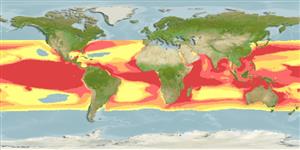分类 / Names
俗名 | 同种异名 | Catalog of Fishes(属, 种) | ITIS | CoL | WoRMS | Cloffa
Elasmobranchii
板鳃亚纲 (鲨鱼与 鱼) (sharks and rays) >
Carcharhiniformes (Ground sharks)
白眼鮫目 (Ground sharks) >
Carcharhinidae (Requiem sharks)
白眼鮫科 (Requiem sharks)
Etymology: Carcharhinus: karcharos (Gr.), sharp or jagged; rhinus, an ancient name for sharks, from rhine (Gr.), rasp, both words alluding to a shark's jagged, rasp-like skin. (See ETYFish); falciformis: falx (L.), scythe or sickle; forma (L.), shape or form, referring to sickle-like shape of pectoral fins [authorship often attributed to Müller & Henle, who published Bibron’s description]. (See ETYFish).
Environment: milieu / climate zone / depth range / distribution range
生态学
海洋 礁区鱼类; 海洋洄游的 (Ref. 51243); 深度上下限 0 - 4000 m (Ref. 55180), usually 0 - 500 m (Ref. 6871). 亞熱帶的; 42°N - 43°S, 180°W - 180°E (Ref. 55180)
Circumtropical. Western Atlantic: Massachusetts, USA to southern Brazil, including the Gulf of Mexico and the Caribbean Sea to Uruguay (Ref. 244, 58839). Eastern Atlantic: Spain, Madeira to northern Angola; St. Paul's Rocks (Ref. 13121); Cape Verde (Ref. 34514). Indo-Pacific: scattered records from the Red Sea and Natal, South Africa (Ref. 5578) to China, New Zealand, and the Caroline, Hawaiian, Phoenix and Line islands. Eastern Pacific: southern Baja California, Mexico to northern Chile. Highly migratory species.
Circumtropical。 西大西洋: 美國麻薩諸塞州到巴西南部, 包括墨西哥灣與加勒比海。 東大西洋: 西班牙, 馬得拉群島到安哥拉北部; 聖保羅岩礁;(參考文獻 13121) 維德角.(參考文獻 34514) 印度-太平洋: 分散的來自紅海與南非的納塔爾 (參考文獻 5578) 的紀錄到中國,紐西蘭, 與加羅林群島,夏威夷語,鳳凰島與列島群島。 東太平洋: 墨西哥的下加利福尼亞南部到智利北部。 高度遷移的種,1982年海事法會議的附件一.(參考文獻 26139)
Length at first maturity / 大小 / 重量 / 年龄
Maturity: Lm 219.1, range 180 - 260 cm
Max length : 350 cm TL 雄鱼/尚未辨别雌雄; (Ref. 9997); common length : 250 cm TL 雄鱼/尚未辨别雌雄; (Ref. 9997); 最大体重: 346.0 kg (Ref. 40637); 最大年龄: 25 年 (Ref. 31395)
背棘 (总数) : 0; 臀棘: 0. A large, slim shark with a moderately long, flat and rounded snout, large eyes, small jaws, and oblique-cusped teeth with serrations; 2nd dorsal fin low and with greatly elongated rear tip (Ref. 5578). Grey or bluish-grey above, white below; no conspicuous fin markings (Ref. 5578). Only Carcharhinus species with an interdorsal ridge that has the dorsal fin origin behind the free rear tip of the pectoral fin (Ref. 26938).
大, 瘦的鲨鱼有中等长度, 平坦的而且圆的吻又大的眼,小的颚, 与斜尖的牙齿有锯齿; 第二背鳍鳍低的而且有极细长的后顶端.(参考文献 5578) 背面灰色或蓝灰色的, 腹面白色的; 没有显着的鳍斑纹.(参考文献 5578) 只有 Carcharhinus 种有一个有背鳍起点在后面胸鳍的鳍游离后端的间背脊。 (参考文献 26938)
Found abundantly near the edge of continental and insular shelves, but also in the open sea and occasionally inshore (Ref. 244). Often found in deepwater reefs and near insular slopes (Ref. 244). Littoral and epipelagic, in the open sea or near the bottom at 18-500 m (Ref. 58302). It is quick-moving and aggressive (Ref. 244). Solitary (Ref. 26340); often associated with schools of tuna (Ref. 244). Feeds mainly on fishes, but also squid, paper nautiluses, and pelagic crabs (Ref. 244; 37816). Viviparous (Ref. 50449). Regarded as dangerous to humans (Ref. 9997). Flesh utilized fresh and dried-salted for human consumption; its hide for leather; its fin for shark-fin soup; its liver for oil (Ref. 244). 2 to 14 young, 73 to 87 cm, are born per litter (Ref. 1602).
大量地在大陆架和岛屿棚边缘的附近发现, 也在开放海域中与偶然近海.(参考文献 244) 时常发现于深水礁区与在岛的斜坡附近.(参考文献 244) 移动快速与侵略性它是。 (参考文献 244) 独居性;(参考文献 26340) 时常伴随着鲔鱼群.(参考文献 244) 主要吃鱼, 也捕食乌贼, 纸鹦鹉螺 , 与大洋性螃蟹 (参考文献 244; 37816)。 胎生的.(参考文献 50449) 被认为了对人类具有危险性.(参考文献 9997) 鱼肉利用生鲜或乾渍供人类消费; 它的隐藏用做皮革; 它的鳍用做鱼翅汤; 它的肝脏用于制造鱼肝油.(参考文献 244) 生产2 到 14 只, 73 到 87 公分的幼鱼每胎。 (参考文献 1602)
Viviparous, placental (Ref. 50449). 2-15 pups (Ref. 6871, 37816) born at 57-87 cm TL (Ref. 9997); 1-16 pups born at 55-72 cm TL. Females appear to breed every year, but there appears to be no reproductive seasonality (Ref. 58048). Distinct pairing with embrace (Ref. 205).Circumtropical。 西大西洋: 美國麻薩諸塞州到巴西南部, 包括墨西哥灣與加勒比海。 東大西洋: 西班牙, 馬得拉群島到安哥拉北部; 聖保羅岩礁;(參考文獻 13121) 維德角.(參考文獻 34514) 印度-太平洋: 分散的來自紅海與南非的納塔爾 (參考文獻 5578) 的紀錄到中國,紐西蘭, 與加羅林群島,夏威夷語,鳳凰島與列島群島。 東太平洋: 墨西哥的下加利福尼亞南部到智利北部。 高度遷移的種,1982年海事法會議的附件一.(參考文獻 26139)
Compagno, L.J.V., 1984. FAO Species Catalogue. Vol. 4. Sharks of the world. An annotated and illustrated catalogue of shark species known to date. Part 2 - Carcharhiniformes. FAO Fish. Synop. 125(4/2):251-655. Rome: FAO. (Ref. 244)
人类利用
渔业: 高经济性
工具
特别资料
下载 XML
网络资源
Estimates based on models
Preferred temperature (Ref.
123201): 12 - 28.9, mean 26.7 °C (based on 8170 cells).
Phylogenetic diversity index (Ref.
82804): PD
50 = 0.5000 [Uniqueness, from 0.5 = low to 2.0 = high].
Bayesian length-weight: a=0.00468 (0.00378 - 0.00579), b=3.08 (3.04 - 3.12), in cm total length, based on LWR estimates for this species (Ref.
93245).
营养阶层 (Ref.
69278): 4.5 ±0.0 se; based on diet studies.
Generation time: 9.2 (7.4 - 13.1) years. Estimated as median ln(3)/K based on 14
growth studies.
回复力 (Ref.
120179): 低的, 最小族群倍增时间4.5 - 14 年 (rm=0.054; K=0.05-0.15; tm=6-10; tmax=25; Fec=2-14).
Prior r = 0.06, 95% CL = 0.04 - 0.09, Based on 3 data-limited stock assessments.
Fishing Vulnerability (Ref.
59153): Very high vulnerability (82 of 100).
Climate Vulnerability (Ref.
125649): Very high vulnerability (76 of 100).
Nutrients (Ref.
124155): Calcium = 2.41 [0.46, 12.84] mg/100g; Iron = 0.321 [0.080, 0.980] mg/100g; Protein = 22.8 [19.9, 25.0] %; Omega3 = 0.211 [0.078, 0.542] g/100g; Selenium = 34.5 [10.6, 105.0] μg/100g; VitaminA = 23 [7, 76] μg/100g; Zinc = 0.281 [0.138, 0.566] mg/100g (wet weight);
